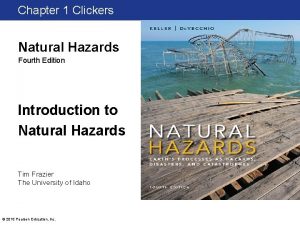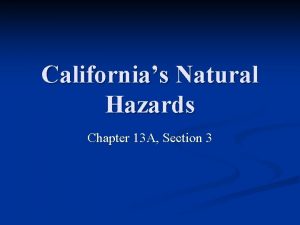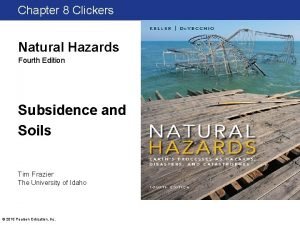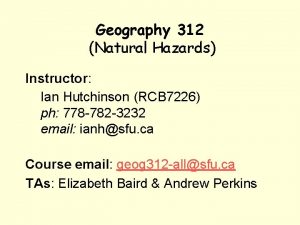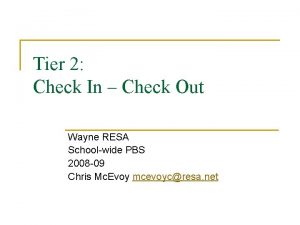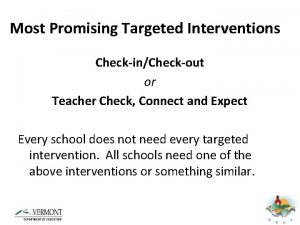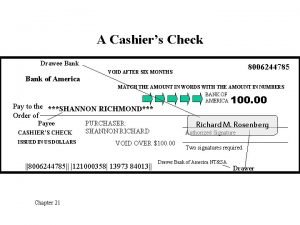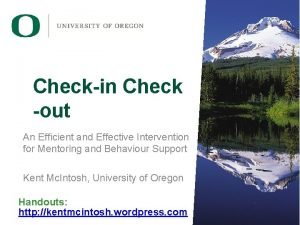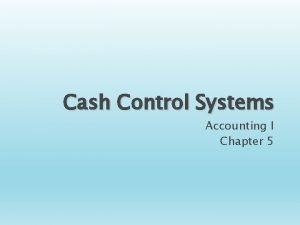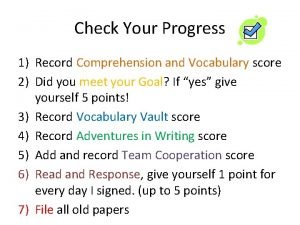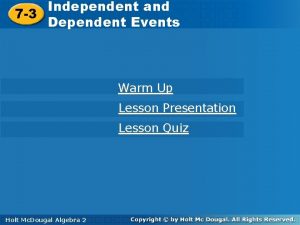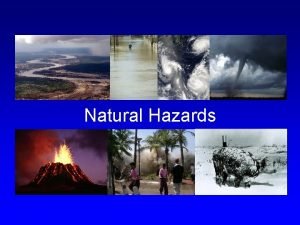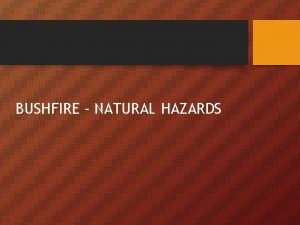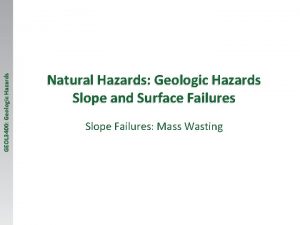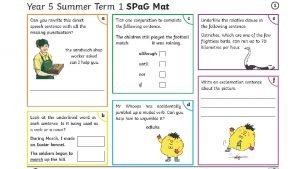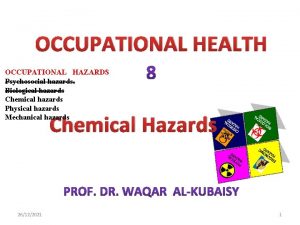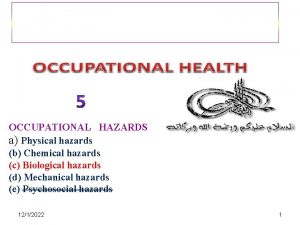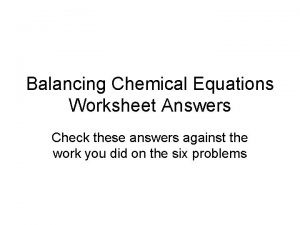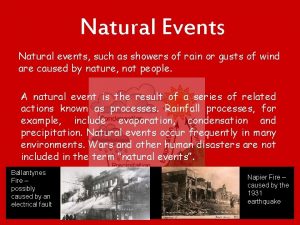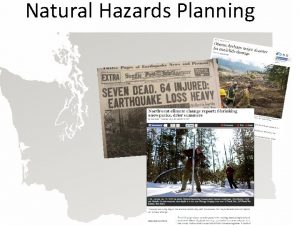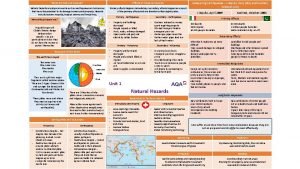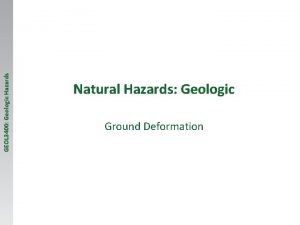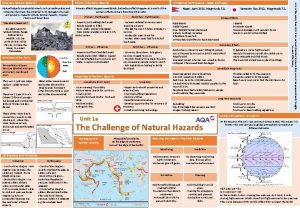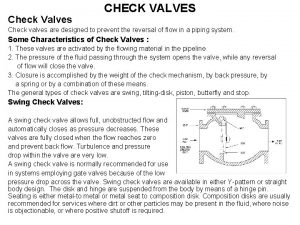Check Answers Here Natural Hazards Natural events that






























- Slides: 30

Check Answers Here

Natural Hazards • Natural events that threaten lives, property, and other assets or, • Elements of the physical environment, harmful to man and caused by forces extraneous to him or, • All atmospheric, hydrologic, geologic, and wildfire phenomena that have potential to affect humans, their structures, or their activities adversely • Can be predicted • Examples are floods, fires, earthquakes, tornadoes, and windstorms

Catastrophic Events • Sudden, natural or man-made, situations where change and destruction may occur without prior knowledge or preparation

Floods

Floods • Flooding happens during heavy rains, when rivers overflow, when ocean waves come onshore, when snow melts too fast or when dams or levees break. • Flooding may be only a few inches of water or it may cover a house to the rooftop.

Floods • Floods that happen very quickly are called flashfloods. • Flooding is the most common of all natural hazards. • It can happen in every U. S. state and territory.

Environmental Impact of Floods • Floods are important in maintaining ecosystem habitats and soil fertility. • Human attempts at managing flood prone areas disrupt the natural flood cycle.

Environmental Impact of Floods • Activities such as drainage of wetlands and land clearance for farming; upstream development that replaces natural vegetation with paved asphalt; and construction of channels, levees, reservoirs change the flood cycle and often result in increases runoff, destruction of riparian habitat, and increased water pollution

Effects of Floods • Floods destroy drainage systems causing raw sewage to spill out into bodies of water. • Buildings can be destroyed which can lead to many toxic materials such as paint, pesticide and gasoline being released into the rivers, lakes, bays, and ocean, killing marine life. • Floods cause significant amounts of erosion to coasts, leading to more frequent flooding if not repaired. • Floods positively impact the environment by spreading sediment containing nutrients to topsoil.

• Plants Effects of a Flood on the Ecosystem – On dry land, plant life can benefit from the sudden appearance of a large quantity of flood water. – Water stored underground will be replenished by the floodwater, while soil above ground will be able to soak up the water. – Plants will be able to receive water as a result. – The nutrients carried by the flood water can also revive deprived plants and aid in the germination of seeds.

• Plants Continued – Flood water may prove a new lease on life for an area. – The soil is likely to be more fertile, leading to a suitable area in which to grow crops. – Flooding can kill woody and herbaceous plants. Effects of a Flood on the Ecosystem

How Flooding Affects Animal Breeding • The environment in areas where floods have occurred are more suitable for the reproduction of species of birds and some other animals. • Fish can breed and give birth in the areas where flood water stays for an extended duration.

Animals • Flooding forces many wild animals from their natural habitats. • Domestic animals are also left without homes after floods. • Rats may be a problem during and after a flood. • The large amounts of pooled water lead to an increase in mosquito populations.

Effects of Floods on Water-Based Ecosystems • Coral reefs are particularly at risk from the runoff from floods. • This runoff contains sediment and products such as pesticides and fertilizers, and will carry these into the ocean ecosystem. • Habitats may be destroyed, and animal and plant life are is likely to suffer. – Sediment may obscure the sunlight which inhibits photosynthesis of marine plants.

Effects of Floods on Water-Based Ecosystems • There are some benefits of flooding on the ocean ecosystems – The sudden appearance of an overflow of water can wash away unneeded salt, alongside man-made products like chemical waste. – This helps the flora and fauna thrive. – The flood water can also sweep away junk and debris which may have accumulated by the side of rivers.

Flood-Related Erosion • The collapse or subsidence of land along the shore of a lake or other body of water as a result of undercurrents of water exceeding anticipated cyclical levels • or suddenly caused by an unusually high water level in a natural body of water, accompanied by a severe storm, • or by an unanticipated force of nature, such as a flash flood or an abnormal tidal surge, or by some similarly unusual and unforeseeable event which results in flooding.

Erosion • Lateral erosion widens the river channel while vertical erosion deepens it. • There are four types of erosion: – – Corrasion or abrasion Attrition Solution or corrosion Hydraulic Action

Erosion – Corrasion or abrasion • The grinding of rock fragments carried by the river against the bed and banks of the river. • The power of the grinding is greater during floods when large fragments of rock are carried along the river bed eroding the bed and the banks.

Erosion – Attrition • The knocking of rock fragments in the water against one another. • The fragments are broken into smaller pieces and become smoother along the process.

Erosion – Solution or corrosion • The process by which river water reacts chemically with soluble minerals in the rocks and dissolves them.

– Hydraulic Action Erosion • The breaking down of rocks and dragging them away from the bed and banks by the force of the running water itself.

Deposition • The opposite of erosion, deposition is where a river lays down or drops sediment or material that it is carrying. • Some types of deposition include: – – – Pebbles or stones Mud and sand silt Large boulders or stones Tree branches Pollution like cans, bottles, wrappers, etc.

• Rainwater rushes down the mountain and into lakes and rivers and then it will continue down to the sea. • Some will seep into the ground as groundwater. Groundwater will eventually seep into lakes and rivers and finally the sea.

Upper Course • Here the river channel is small, narrow, rough, and usually shallow, • The stones and rocks increase wetted perimeter, • And the volume of water is low as there are very few tributaries flowing into it.

Middle Course • Here the river channel is both wider and deeper, • Its cross-section is asymmetrical, • And a steep river cliff develops on the concave bank and a gentle slip-off slope on the convex bank.

Lower Course • Here the river channel is at its widest and deepest, • It has the largest volume of water and load because of tributaries, • And there is lateral erosion along this course.

Weather Conditions Affect Water Flow • When there is a lot of heavy rainfall and it lasts a long time, there will be a lot of run-off. • Because of this water reaches the river quickly. • During this period the ground can no longer soak up water and flooding can occur.

If there are rocks in the river are they: • Permeable – Permeable rock will allow water infiltration to occur. – This reduces run-off and the chances for flooding. • Or impermeable – Impermeable rock does not allow water to pass through it. – This causes lots of run-off.

Land Use: • Trees delay water by intercepting it. This reduces run-off. • Land that is built on will have more run-off because the ground is covered by impermeable surface like tarmac and concrete.

Dams • Dams will hold floodwaters back.
 Natural hazards vs natural disasters
Natural hazards vs natural disasters Phân độ lown ngoại tâm thu
Phân độ lown ngoại tâm thu Block xoang nhĩ là gì
Block xoang nhĩ là gì Thể thơ truyền thống
Thể thơ truyền thống Thơ thất ngôn tứ tuyệt đường luật
Thơ thất ngôn tứ tuyệt đường luật Chiến lược kinh doanh quốc tế của walmart
Chiến lược kinh doanh quốc tế của walmart Tìm vết của đường thẳng
Tìm vết của đường thẳng Hãy nói thật ít để làm được nhiều
Hãy nói thật ít để làm được nhiều Tôn thất thuyết là ai
Tôn thất thuyết là ai Gây tê cơ vuông thắt lưng
Gây tê cơ vuông thắt lưng Sau thất bại ở hồ điển triệt
Sau thất bại ở hồ điển triệt Mutually exclusive vs non mutually exclusive
Mutually exclusive vs non mutually exclusive Natural hazards 4th edition
Natural hazards 4th edition California natural hazards
California natural hazards How does the study of soils help evaluate natural hazards?
How does the study of soils help evaluate natural hazards? Why is canada rarely impacted by natural weather hazards
Why is canada rarely impacted by natural weather hazards Geog 312 sfu
Geog 312 sfu There's a place where streams of grace
There's a place where streams of grace Checking account simulation
Checking account simulation Behavior check in check out sheet
Behavior check in check out sheet Behavior check in check out sheet
Behavior check in check out sheet Check in check out
Check in check out Check in check out system
Check in check out system Where is the check number on a cashier's check
Where is the check number on a cashier's check Raster scan line in computer graphics
Raster scan line in computer graphics Checkin checkout system
Checkin checkout system Check-in check-out intervention
Check-in check-out intervention The fan blade is speeding up. what are the signs of
The fan blade is speeding up. what are the signs of Chapter 5 cash control systems answer key
Chapter 5 cash control systems answer key Check your progress 1
Check your progress 1 Independent vs dependant events
Independent vs dependant events












